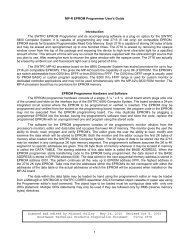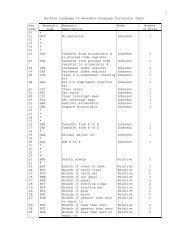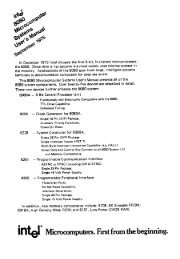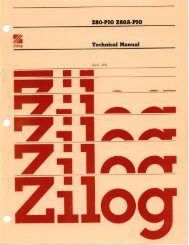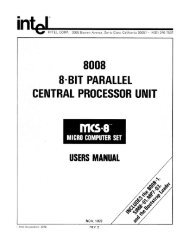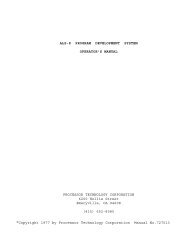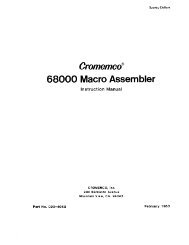The System Manual of SOL-20 - History of Computers
The System Manual of SOL-20 - History of Computers
The System Manual of SOL-20 - History of Computers
Create successful ePaper yourself
Turn your PDF publications into a flip-book with our unique Google optimized e-Paper software.
PROCESSOR TECHNOLOGY CORPORATION<br />
Sol THEORY OF OPERATION<br />
SECTION VIII<br />
As previously stated, the second stage <strong>of</strong> U101 is allowed to<br />
change state on the positive going transitions <strong>of</strong> the OUTPUT_CLOCK as<br />
long as the data out <strong>of</strong> the synchronizer is a "1". <strong>The</strong> end result is<br />
an output on pin 14 <strong>of</strong> U101 that is one-half the clock frequency<br />
(1<strong>20</strong>0 Hz and 2400 Hz in the high and low speed modes respectively).<br />
Assume the data stream out <strong>of</strong> the UART goes low ("0"). On<br />
the next rising edge <strong>of</strong> the 1<strong>20</strong>0 Hz signal, U100 will reset with Q<br />
low and !Q high. A low reset on pin 4 <strong>of</strong> U101 enables the first U101<br />
stage to toggle on the next rising edge <strong>of</strong> the OUTPUT_CLOCK which occurs<br />
1/2400 second after the synchronizer output falls. Remember<br />
that OUTPUT_CLOCK moves from a low to a high shortly before the 1<strong>20</strong>0<br />
Hz signal did. <strong>The</strong> reset on pin 4 <strong>of</strong> U101 is thus removed slightly<br />
after the OUTPUT_CLOCK occurred. With the J and K inputs to the<br />
first U101 stage high, its output will change state on each succeeding<br />
low to high transition <strong>of</strong> OUTPUT_CLOCK. <strong>The</strong> second U101 stage in<br />
turn can only toggle on the positive going transition <strong>of</strong> OUTPUT_CLOCK<br />
when its J and K inputs are high. Since the inputs are high at onehalf<br />
the clock rate, by virtue <strong>of</strong> the first U101 stage, the second<br />
U101 stage toggles at one-fourth the OUTPUT_CLOCK rate.<br />
<strong>The</strong> two sections <strong>of</strong> U101, therefore, operate as a frequency<br />
divider, dividing the OUTPUT_CLOCK by two when the write data is a<br />
"1" and by four when the data is a "0". Thus, in the low speed mode,<br />
four cycles <strong>of</strong> the 1<strong>20</strong>0 Hz represent a "0" and eight cycles <strong>of</strong> 2400<br />
Hz represent a "l". In the high speed mode, one cycle <strong>of</strong> 1<strong>20</strong>0 Hz represents<br />
a "1" and one-half cycle <strong>of</strong> 600 represents a "0".<br />
<strong>The</strong> output on pin 14 <strong>of</strong> U101 is applied to one section in<br />
U109 which provides sufficient current drive for the divider network.<br />
This divider and a jumper arrangement allow selecting one <strong>of</strong> three<br />
outputs to be fed to the audio output jack J6. <strong>The</strong> I-to-J jumper selects<br />
a 500 mv signal for the auxiliary input to an audio recorder;<br />
the I-to-H jumper selects a 50 mv signal for the microphone input to<br />
an audio recorder.<br />
When the CDI is in the read mode, data from the recorders<br />
enters on J7. This input is fed to the negative input (pin 6) <strong>of</strong><br />
operational amplifier U108.<br />
<strong>The</strong> first section <strong>of</strong> U108 is a high gain amplifier, with its<br />
gain (approximately 100) being determined by R142 and R143. <strong>The</strong> output<br />
from this amplifier is coupled to input pin 2 <strong>of</strong> the following<br />
U108 stage and the base <strong>of</strong> a Darlington pair (Q4 and Q5) which provides<br />
high current gain.<br />
Current into the base <strong>of</strong> transistor Q5 causes C67 to discharge.<br />
(C67 charges through R39 to 5 V dc.) <strong>The</strong> voltage on C67 in<br />
turn controls the gate <strong>of</strong> field effect transistor (FET) Q3. Q3 functions<br />
as a variable resistor which can be changed by its gate voltage.<br />
Since Q3 is connected between ground and the input network to the<br />
VIII-36



